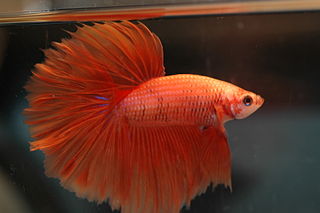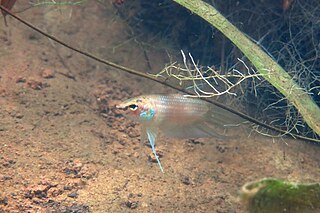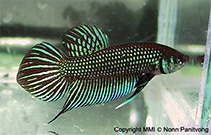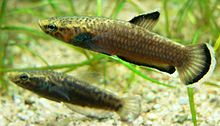
Gouramis, or gouramies, are a group of freshwater anabantiform fish that comprise the family Osphronemidae. The fish are native to Asia—from the Indian Subcontinent to Southeast Asia and northeasterly towards Korea. The name "gourami", of Indonesian origin, is also used for fish of the families Helostomatidae and Anabantidae.

The Penang betta is a species of gourami native to Southeast Asia and common in swiftly flowing forest streams of the Malay Peninsula, Thailand, Sumatra, and the Riau Islands. In addition to its native range, the species has been introduced to Guam. It can be found amongst the vegetation growing along the banks. This species can reach a length of 6.7 centimetres (2.6 in) SL. It is one of the mouthbrooding Betta species. This species, as a natural predator of mosquito larvae, has found use in mosquito control efforts. Prior to its being eclipsed in Western public recognition by the mass-imported B. splendens, B. pugnax was well known as a fighting fish, as denoted by the specific epithet of pugnax, attracting the interest of scientists studying animal behaviour at least as long ago as the 1880s.

The Siamese fighting fish, commonly known as the betta, is a freshwater fish native to Southeast Asia, namely Cambodia, Laos, Myanmar, Malaysia, Indonesia, Thailand, and Vietnam. It is one of 73 species of the genus Betta, but the only one eponymously called "betta", owing to its global popularity as a pet; Betta splendens are among the most popular aquarium fish in the world, due to their diverse and colorful morphology and relatively low maintenance.
The spotted betta or Java fighting fish is a species of gourami endemic to Indonesia where it inhabits relatively cool, 22‒25 °C (72‒75 °F), highland streams of Java. In 1967, D. S. Johnson reported the species to be common in blackwaters of southern Malaya.

Hemibagrus is a genus of catfishes of the family Bagridae.

Parosphromenus is a genus of gouramies native to freshwater in Southeast Asia. All species are highly specialized peat swamp inhabitants native to southeast Asia, and the males are usually brightly colored in breeding dress; however, their need for soft, acidic water and live food prohibits the genus from becoming popular aquarium fish.

Betta albimarginata is a species of betta fish, endemic to the island of Borneo where it is only found in the Indonesian province of Kalimantan Timur. It inhabits the shallows of forest streams amongst vegetation and debris along the shores. This species grows to a length of 2.8 cm (1.1 in). It is a mouthbrooding species.

Betta ferox is a species of gourami endemic to Thailand. It is only found in rivers in Songkhla Province, where it resides along shallow riverbanks among vegetation. This species grows to a length of 6.3 centimetres (2.5 in) SL. This species is closely related to Betta pugnax and is also a paternal mouthbrooder. Males and females are dimorphic, with males displaying elongated ventral fins, elongated caudal fins, and green coloration on the gill plates. Females typically display two horizontal brown bars across their bodies, shorter fins, and a more rounded body shape.

The Macropodusinae are a subfamily of freshwater anabantiform fishes in the gourami family Osphronemidae, which includes the paradisefish, fighting fish and licorice gouramis. Like all members of the family, these are air breathing fishes that frequently inhabit oxygen poor environments hostile to other fishes. They are native to Asia, from Pakistan and India to the Malay Archipelago and north-easterly towards Korea. Many members are common aquarium fish; by far the most famous is the Siamese fighting fish, Betta splendens. Most of the 70+ betta species are paternal mouthbrooders; the remaining members of the subfamily are bubblenesters like most osphronemids.
Heok Hui Tan is a Singaporean ichthyologist at the Lee Kong Chian Natural History Museum of the National University of Singapore. Dr. Tan's main interest lies in the systematics of Southeast Asian freshwater fishes, encompassing taxonomy, ecology and biogeography. His primary areas of research focus on neglected and de novo habitats such as peat swamp forests, swamp forests, and rapids.
Betta akarensis, the Akar betta, is a species of gourami endemic to south-east Sarawak, and whose species name akar was so named after where it was originally found in the river Sungai Akar. This species is a mouthbrooder, and grows to a length of 10 centimetres (3.9 in) SL. According to Linke, they "live predominantly in mineral-poor, slightly acid water enriched with humic substances".
Betta antoni is a species of gourami endemic to the Sanggau area in the Kapuas region. The species name antoni is named after Irwan Anton "in recognition of his generous help and gift of specimens". This species grows to a length of 8 centimetres (3.1 in) SL. According to Linke, they live in "densely vegetated, narrow watercourses with very soft, very acidic water"
Betta aurigans is a species of gourami endemic to the island of Natuna Besar, north-west of the island of Borneo The species name aurigans is so named after the Latin for gold, due to the colouring of the scales of the fish. According to Linke, they live in "blackwater swamp regions"

Betta mahachaiensis is a species of bubble-nesting betta native to Thailand, where it occurs naturally near the Gulf of Thailand. It is typically seen in stagnant waters in swamps, pools, and ponds. The species can be found in brackish waters, with salinity levels between 1.1 and 10.6 parts per thousand. Betta mahachaiensis is capable of living in both fresh water and brackish water, a trait unique among fish in the genus Betta. This species grows to a length of 5 to 6 cm. It is found in the aquarium trade.
Betta obscura is a species of gourami that occurs in the Barito basin in Kalimantan Tengah, Indonesia. This species is a mouthbrooder, and grows to a length of around 9 centimetres (3.5 in) SL.
Betta pardalotos is a species of fish in the family Osphronemidae. It is native to Asia, where it occurs in the Musi River basin on the island of Sumatra in Indonesia. The species reaches 7.2 cm in standard length and is known to be a facultative air-breather. It feeds on insects and other small invertebrates such as zooplankton.
Betta breviobesa is a species of gourami. It is native to Asia, where it occurs in the upper Kapuas River basin in West Kalimantan on the island of Borneo in Indonesia. The species reaches 6.5 centimetres (2.6 in) in standard length and is known to be a facultative air-breather. It was described in 1998 by Heok Hui Tan and Maurice Kottelat alongside the species Betta pinguis, which also occurs in the Kapuas basin.
Betta kuehnei is a species of gourami. It is native to Asia, where it occurs in Malaysia and Thailand. It is typically found in shallow, shaded forest creeks among aquatic plants such as Cryptocoryne cordata and leaf litter. The water in which the species occurs is clear, with a pH of 7, a hardness of 3 dGH, and a temperature of 25 °C. It is known to occur alongside the species Parosphromenus paludicola and Trichopsis vittata. The species reaches 8 cm in total length and is known to be a facultative air-breather. Males of the species exhibit mouthbrooding.
Betta andrei is a species of gourami in the family Osphronemidae. It is a black water fighting fish that is endemic to Singkep Island, Indonesia. It was described in 2023 by Heok Hui Tan, who named it after Andre Chandra, a fish collector and enthusiast who helped him during his fieldwork.












